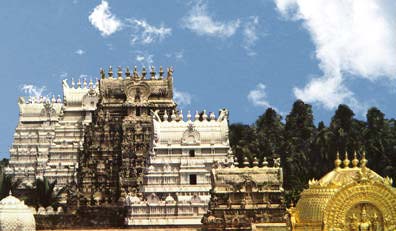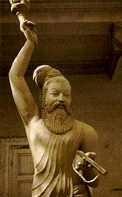Article review- Vastu Shastra and Sacred architecture
Debating with my dad about the Vastu shastra and Indian architecture history, during renovation of my house I came across this article he shared with me about VASTU SHASTRA AND SACRED ARCHITECTURE by Swami B.G. Narashingha
As article begins with the greatness of Indian architecture history that has been marveled effortlessly since ages in Indian 'VEDA'
Time, the destroyer of all things, vanquishes even the most invincible empires leaving behind their remnants to be marveled at by future civilizations. And marvel we do at the wonders of the past, especially the architectural wonders. Be it the pyramids of Egypt, the cathedrals of Rome, the Parthenon of Athens, the Forbidden City in Beijing, or Stonehenge, our mind is at once awed by the beauty and grandeur of ancient architecture.
Then it describes an example on effect of sacred architecture in human body present in today's life. "The Lindisfarne chapel" that brings the sense of sacred calling to everyone who enters that holy place. Being a believer of sacred architecture as a metaphor or just a technique to form beautiful and harmonically stable structures I was amazed to read about this chapel and read more about it, might add it later on the blog for the readers.

Here's the glimpse of that article which can literally make you believe in sacred architecture and its holy power.
Throughout the world it's hard to find a place where sacred architecture is as developed a science as is that found in India. India's ancient temples and palaces are certainly among the finest ever built. From the Taj Mahal, the seventh wonder of the world, to the Pagodas of Tamil Nadu, from the Himalayan hill shrines to the great temple at Jagannatha Puri, India is a veritable treasure-house of sacred architecture. In fact there are more existing examples of sacred architecture in India than in all other countries of the world combined.
The knowledge of sacred architecture in India has existed in the oral tradition since before the Vedic Age, some five thousand years ago. From the oral tradition it was later recorded in the Sanskrit mantras and compiled under the title Vastu Shastra. According to Indian authorities the Vastu Shastra is possibly the oldest known architectural treatise in the world today.
The word shastra means literature or more accurately "enlightened literature." The word vastu, meaning the manifest, comes from the word vustu, meaning the unmanifest. The philosophical purport of the words vustu and vastu form the basic concepts of India's sacred architecture and are among the first lessons taught to the students of Vastu Shastra. That which is manifest in this world, vastu, it is said, is originally existing on the plane of the transcendental or unmanifest, vustu.
To instruct the beginning students of the Vastu Shastraabout the meanings of vustu and vastu, the unmanifest and the manifest realities, the example is used of the moon and its reflection in water. "The moon is present in the sky, but when rising above a lake it becomes visible or manifest in the water. In the same way the origin of all things exists first in the eternal reality and then becomes manifest here below in the world of gross sensual objects." This simple analogy demonstrates the nature of vustu, that which exists eternally, and vastu, that which is temporarily manifest.
The students of the Vastu Shastra thus perceive existence in terms of two dimensions: first the infinite spiritual realm and second the finite accommodating space for insentient material objects. This concept of a superior plane of existence, where the original form of things exist eternally, is the basis of India's sacred architecture.
Maya danava, founder of
sacred architecture
 While researching sacred architecture we talked with Ganapati Sthapati, the Senior Architect at the Government College of Architecture and Sculpture in Mahabalipuram, South India. Sthapati informed us that the science of the Vastu Shastra is traceable to at least the year 3000 B.C., if not before. The earliest known master of the Vastu Shastra was Maya Danava, recognized as the founder of the tradition of India's sacred architecture. Sthapati, who holds the esteemed title Brahma Sri, awarded to him by the government of India for his achievements in the field of architecture, further assured us that the science of Vastu Shastra is a living tradition in India and is in no danger of becoming extinct.
While researching sacred architecture we talked with Ganapati Sthapati, the Senior Architect at the Government College of Architecture and Sculpture in Mahabalipuram, South India. Sthapati informed us that the science of the Vastu Shastra is traceable to at least the year 3000 B.C., if not before. The earliest known master of the Vastu Shastra was Maya Danava, recognized as the founder of the tradition of India's sacred architecture. Sthapati, who holds the esteemed title Brahma Sri, awarded to him by the government of India for his achievements in the field of architecture, further assured us that the science of Vastu Shastra is a living tradition in India and is in no danger of becoming extinct.We visited several classrooms at the college where students are taught the variety of skills and techniques necessary in the science of sacred architecture. Beginning with concept and design, the students are taught each and every aspect of sacred architecture: geometry, drafting, stone sculpture, bronze casting, wood carving, painting, etc. All the textbooks and reference materials are written in Sanskrit, which every student is required to learn.
Those students who excel in all phases of sacred architecture will graduate with a degree in architectue and receive the title Sthapati. Those students specializing in a particular department of sacred architecture like sculpture or painting become certified as Master Artisans. After earning a degree graduating students will have the opportunity to apply their designing skills in building temples and other facilities requiring knowledge of the Vastu Shastra.
Of all types of structures in the field of sacred architecture, the building of a temple requires the utmost degree of knowledge and training. Those building a house, a school or even an office building take into consideration the basic knowledge of sacred architecture for successful execution; but the temple, being the very abode of divinity, requires the greatest skills and is the most painstaking in its execution. In the development of a temple project all phases of construction from beginning to end are thought out and executed according to the direction of the Vastu Shastra.



Comments
Post a Comment